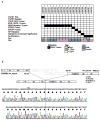Genetic alterations in uncommon low-grade neuroepithelial tumors: BRAF, FGFR1, and MYB mutations occur at high frequency and align with morphology
- PMID: 26810070
- PMCID: PMC4866893
- DOI: 10.1007/s00401-016-1539-z
Genetic alterations in uncommon low-grade neuroepithelial tumors: BRAF, FGFR1, and MYB mutations occur at high frequency and align with morphology
Abstract
Low-grade neuroepithelial tumors (LGNTs) are diverse CNS tumors presenting in children and young adults, often with a history of epilepsy. While the genetic profiles of common LGNTs, such as the pilocytic astrocytoma and 'adult-type' diffuse gliomas, are largely established, those of uncommon LGNTs remain to be defined. In this study, we have used massively parallel sequencing and various targeted molecular genetic approaches to study alterations in 91 LGNTs, mostly from children but including young adult patients. These tumors comprise dysembryoplastic neuroepithelial tumors (DNETs; n = 22), diffuse oligodendroglial tumors (d-OTs; n = 20), diffuse astrocytomas (DAs; n = 17), angiocentric gliomas (n = 15), and gangliogliomas (n = 17). Most LGNTs (84 %) analyzed by whole-genome sequencing (WGS) were characterized by a single driver genetic alteration. Alterations of FGFR1 occurred frequently in LGNTs composed of oligodendrocyte-like cells, being present in 82 % of DNETs and 40 % of d-OTs. In contrast, a MYB-QKI fusion characterized almost all angiocentric gliomas (87 %), and MYB fusion genes were the most common genetic alteration in DAs (41 %). A BRAF:p.V600E mutation was present in 35 % of gangliogliomas and 18 % of DAs. Pathogenic alterations in FGFR1/2/3, BRAF, or MYB/MYBL1 occurred in 78 % of the series. Adult-type d-OTs with an IDH1/2 mutation occurred in four adolescents, the youngest aged 15 years at biopsy. Despite a detailed analysis, novel genetic alterations were limited to two fusion genes, EWSR1-PATZ1 and SLMAP-NTRK2, both in gangliogliomas. Alterations in BRAF, FGFR1, or MYB account for most pathogenic alterations in LGNTs, including pilocytic astrocytomas, and alignment of these genetic alterations and cytologic features across LGNTs has diagnostic implications. Additionally, therapeutic options based upon targeting the effects of these alterations are already in clinical trials.
Keywords: BRAF; FGFR1; Glioma; Glioneuronal; MYB; RNA-seq.
Figures





References
-
- Andre F, Bachelot T, Campone M, Dalenc F, Perez-Garcia JM, Hurvitz SA, Turner N, Rugo H, Smith JW, Deudon S, Shi M, Zhang Y, Kay A, Porta DG, Yovine A, Baselga J. Targeting FGFR with dovitinib (TKI258): preclinical and clinical data in breast cancer. Clin Cancer Res. 2013;19:3693–3702. doi: 10.1158/1078-0432.CCR-13-0190. - DOI - PubMed
-
- Bandopadhayay P, Bergthold G, London WB, Goumnerova LC, Morales La Madrid A, Marcus KJ, Guo D, Ullrich NJ, Robison NJ, Chi SN, Beroukhim R, Kieran MW, Manley PE. Long-term outcome of 4,040 children diagnosed with pediatric low-grade gliomas: an analysis of the Surveillance Epidemiology and End Results (SEER) database. Pediatr Blood Cancer. 2014;61:1173–1179. doi: 10.1002/pbc.24958. - DOI - PMC - PubMed
-
- Becker AP, Scapulatempo-Neto C, Carloni AC, Paulino A, Sheren J, Aisner DL, Musselwhite E, Clara C, Machado HR, Oliveira RS, Neder L, Varella-Garcia M, Reis RM. KIAA1549: BRAF Gene Fusion and FGFR1 Hotspot Mutations Are Prognostic Factors in Pilocytic Astrocytomas. J Neuropathol Exp Neurol. 2015;74:743–754. doi: 10.1097/NEN.0000000000000213. - DOI - PMC - PubMed
MeSH terms
Substances
Grants and funding
LinkOut - more resources
Full Text Sources
Other Literature Sources
Medical
Research Materials
Miscellaneous

